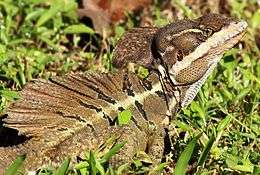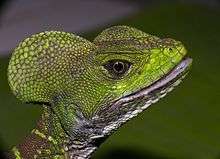Basiliscus (genus)
Basiliscus is a genus of large corytophanid lizards, commonly known as basilisks, which are endemic to southern Mexico, Central America, and northern South America. The genus contains four species, which are commonly known as the Jesus Christ lizard, or simply the Jesus lizard, due to their ability to run across water for significant distances before sinking.
| Basilisks | |
|---|---|
 | |
| Brown basilisk, Basiliscus vittatus, Costa Rica | |
| Scientific classification | |
| Kingdom: | Animalia |
| Phylum: | Chordata |
| Class: | Reptilia |
| Order: | Squamata |
| Suborder: | Iguania |
| Family: | Corytophanidae |
| Genus: | Basiliscus Laurenti, 1768 |
| Species | |
|
Four, see text. | |
Taxonomy and etymology
Both the generic name, Basiliscus, and the common name, "basilisk", derive from the Greek basilískos (βασιλίσκος) meaning "little king". The specific epithet, vittatus, which is Latin for "striped", was given in Carl Linnaeus' 10th edition of Systema Naturae.[1]
Physiology
Basilisks on average measure 70 to 75 cm (28 to 30 in) in total length (including tail). Their growth is perpetual, fast when they are young and nonlinear for mature basilisks. Their long crest-like sails, reinforced in three distinct points (head, back, and tail), confer the impression of creatures such as Dimetrodon and Edaphosaurus. Their skin is shed in pieces.
Running on water
Basilisks sometimes run bipedally. Basilisks have the ability to "run" on water, and because of this, they have been dubbed the "Jesus Christ lizard" in reference to the biblical passage of Matthew 14:22-34.[2] On water, basilisks can run at a velocity of 1.5 meters (4.9 feet) per second for approximately 4.5 meters (15 feet) before sinking on all fours and swimming. Flaps between their toes help support basilisks, creating a larger surface and pockets of air, giving them the buoyancy needed to run across water. They can also sustain themselves on all fours while "water-walking" to increase the distance travelled above the surface by about 1.3 meters (4.3 feet).
A similar behavior, running bipedally across water, is known from the sailfin lizards and a few species of anole lizards.[3][4] Basilisks and sailfin lizards share the specialized toe fringes, which however are lacking in the anoles.[4]
Other defense mechanisms
Basilisks can burrow into sand to hide from predators; a ring of muscles around both nostrils prevents sand from entering the nose.
Habitat and geographic range
Basilisks are abundant in the tropical rain forests of Central and South America, from southern Mexico to Ecuador and Venezuela.

Invasive species
The species Basiliscus vittatus (brown basilisk) has been introduced to Florida.[5] It has adapted to the colder winters by burrowing into leaf litter for warmth. Current reports sight the brown basilisk as far north as Fort Pierce, on the state's East Coast, where small groups have crept up the North Fork of the Saint Lucie River. Mainly it has been seen in Boca Raton and other cities in Palm Beach County. as seen in this photo taken in West Palm Beach, Florida.
Classification
Genus Basiliscus[6]
- Basiliscus basiliscus (Linnaeus, 1758) – common basilisk
- Basiliscus galeritus A.M.C. Duméril & A.H.A. Duméril, 1851 – red-headed basilisk
- Basiliscus plumifrons Cope, 1875[7] – plumed basilisk
- Basiliscus vittatus Wiegmann, 1828 – brown basilisk, striped basilisk
Extant Species
| Image | Scientific name | Common Name | Distribution |
|---|---|---|---|
.jpg) | Basiliscus basiliscus | common basilisk | from southwestern Nicaragua to northwestern Colombia on the Pacific side, and from central Panamá to northwestern Venezuela |
 | Basiliscus galeritus | western basilisk, or red-headed basilisk | western Colombia and western Ecuador |
 | Basiliscus plumifrons | plumed basilisk,green basilisk, the double crested basilisk | eastern Honduras, through Nicaragua and Costa Rica, to western Panama |
_(6775707063).jpg) | Basiliscus vittatus | brown basilisk, striped basilisk | Mexico, Central America and adjacent northwestern Colombia, |
References
- Sprackland, Robert George (1992). Giant lizards. Neptune, New Jersey: T.F.H. Publications. ISBN 0-86622-634-6.
- How "Jesus Lizards" Walk on Water. News.nationalgeographic.com. Retrieved on 2010-08-19.
- Leal, Knox & Losos (2002). Lack of divergence in aquatic Anolis lizards. Evolution 56(4): 785–791. doi:10.1554/0014-3820(2002)056[0785:LOCIAA]2.0.CO;2
- Bauer; Jackman (2008). "Global diversity of lizards in freshwater (Reptilia: Lacertilia)". Hydrobiologia. 595 (1): 581–586. doi:10.1007/s10750-007-9115-0.
- Powell R, Conant R, Collins JT (2016). Peterson Field Guide to Reptiles and Amphibians of Eastern and Central North America, Fourth Edition. Boston and New York: Houghton Mifflin Harcourt. xiv + 494 pp., 47 plates, 207 figures. ISBN 978-0-544-12997-9. (Basiliscus vittatus, p. 276 + Plate 24).
- "Basiliscus ". The Reptile Database. www.reptile-database.org.
- "Basiliscus plumifrons ". The Reptile Database.
External links
- Jesus Lizard Robot An attempt at building a robotic version of the Jesus Lizard
- How "Jesus Lizards" Walk on Water
- Jesus Lizards Walk on Water Video
Further reading
- Boulenger GA (1885). Catalogue of the Lizards in the British Museum (Natural History). Second Edition. Volume II. Iguanidæ ... London: Trustees of the British Museum (Natural History). (Taylor and Francis, printers). xiii + 497 pp. + Plates I-XXIV. (Genus Basiliscus, pp. 106-107).
- Laurenti JN (1768). Specimen medicum, exhibens synopsin reptilium emendatam cum experimentis circa venena et antidota reptilium austriacorum. Vienna: Joan. Thom. Nob. de Trattnern. 214 pp. + Plates I-V. (Basiliscus, new genus, p. 50). (in Latin).